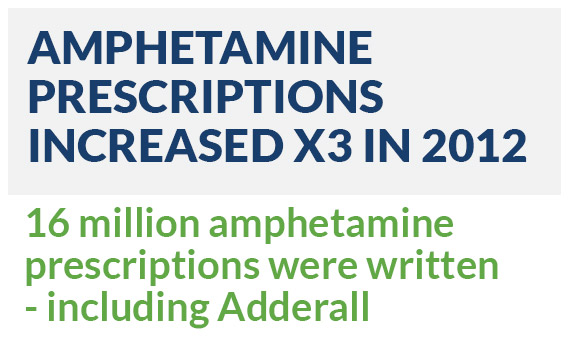Cocaine and Adderall: Dangers, Contraindications and Statistics

Although cocaine is still legitimately prescribed as a local anesthetic, it remains one of the world’s most illicitly abused substances. Smuggled by Columbian and Mexican drug lords and hustled on the street, cocaine is as profitable as it is deadly. Shedding its earlier reputation as the glamor drug of the 1970s, cocaine singlehandedly represents an entire underworld of criminal activity and death. Overdoses, violent altercations, mass incarcerations, traffic-related casualties and political corruption are all linked to the drug, both domestically and abroad.

Adderall is another popular psychostimulant predominantly used to treat attention deficit hyperactivity disorder (ADHD). Unlike cocaine, Adderall is legally available in refillable prescription form and recreationally abused with different intent. College students, for example, use the drug (often by snorting) to plow through all-night study sessions and boost their grade point averages (GPAs). The intensely focused and alert state Adderall induces may at first appear to offer academic advantages; however, students who recreationally abuse adderall as a “study drug” suffer from lower GPAs on average.

ADVERSE REACTIONS ASSOCIATED WITH COCAINE
According to the National Institute on Drug Abuse (NIDA), cocaine usually produces a high within five minutes once it is smoked or injected. Typically, this elevated state diminishes within 10 minutes. Conversely, if snorted, cocaine is capable of sustaining a high for as long as a half hour in certain cases. In either instance, cocaine has an extremely short-half life, with fleeting benefits and damaging side effects.
Cocaine works by targeting dopamine (a primary neurotransmitter) receptors in the brain. Although cocaine interacts with norepinephrine and serotonin to a lesser extent, the potent high induced by the drug stems from the flood of dopamine it unleashes. Regardless of how desirable the euphoria attributed to cocaine may be, it is accompanied by the following adverse reactions or withdrawal symptoms—many of which can turn deadly:
[one-half-first]
- Decreased appetite
- Increased body temperature
- Constricted blood vessels
- Psychosis
- Insomnia
- Dilated pupils
- Uncontrollable cravings
[/one-half-first]
[one-half]
- Dangerous impulsivity and risk taking
- Extreme agitation
- Digestive upset
- Abdominal pain
- Vomiting
- Damaged nasal lining
[/one-half][clearfix]
ADVERSE REACTIONS & SYMPTOMS ASSOCIATED WITH ADDERALL
Adderall works through two distinct neurochemical mechanisms. First and foremost, it prevents the brain from reabsorbing three major neurotransmitters: dopamine, serotonin and norepinephrine. This artificially increases the levels of each neurotransmitter, producing an energetic, alert and highly focused state. Dopamine, part of the brain’s innate pleasure and reward system, is particularly responsive to the stimulant effects of Adderall. Norepinephrine, a stress hormone that activates brain response and heightens awareness, is almost equally responsive. Adderall also works by entering certain areas of the brain where it triggers the release of more neurotransmitters. Together, this manipulation of brain chemistry is accompanied by the following adverse reactions, prompting the FDA to include a “black box” warning label on the drug in recent years:
[one-half-first]
- Dangerous impulsivity and risk taking
- Impaired judgment
- Distorted cognitive function
- Depression
- Hallucinations
- Irritability and aggression
- Disorientation
[/one-half-first]
[one-half]
- Psychosis
- Insomnia
- Mood swings
- Abdominal Pain
- Weight loss
- Dry mouth
- Heart disease
[/one-half][clearfix]
For a more detailed explanation, we suggest reading our guide on Adderall side effects.
THE DANGERS OF MIXING COCAINE AND ADDERALL
Concurrent cocaine and Adderall use is an incredibly volatile, unsafe practice. Such illicit combination heightens the already potent psychostimulant effects associated with both drugs and may result in an increased heat rate which can cause a deadly cardiovascular overreaction. Simply put, the brain, heart and central nervous system (CNS) are not equipped to handle the assault. In adolescents whose neurodevelopment is not yet complete, long-term effects associated with concurrent Adderall and cocaine abuse include permanent brain damage and a debilitating battery of psychological and physiological consequences—including coma and death.
CUMULATIVE EFFECTS ON THE BRAIN
As previously explained, cocaine and Adderall’s highly addictive properties are caused by their artificial manipulation of brain chemicals known as “neurotransmitters.” Dopamine, the primary neurotransmitter responsible for the “high” produced by both drugs, rewires the brain’s pleasure and reward center with chronic use. Even one-time use can produce a series of permanent changes, altering neural pathways, distorting perception and dysregulating emotions.
One well-established change in the brain that is associated with cocaine and Adderall abuse involves the premature death of gray matter, a process that naturally occurs during aging, but is accelerated as a result of addiction. This death of gray matter, in turn, negatively impacts cognition function.
Although the human brain features an innate capacity to heal itself over time—a process known as neuroplasticity— once severely abused, it cannot be replaced. Similar to a computer infected by a virus, certain software programs can be re-installed but the hardware remains permanently damaged.
The neural synapses that regulate cognition and control “executive functioning” in the cerebral cortex are particularly fragile in adolescents, the cohort most affected by cocaine and Adderall abuse. This executive functioning is a critical aspect of reason and impulse control. Once damaged, even ordinary daily tasks can become difficult, and serious social, professional and legal consequences inevitably follow.
SEEKING HELP
If you or someone you love is struggling with cocaine and/or Adderall dependence, consult a substance abuse professional today. The long-term consequences of cocaine and Adderall addiction are extremely serious and delaying treatment is never optimal. Get help now— the life you could be saving may be your own.
For more about cocaine and Adderall addiction and recovery, check out these related articles:
- Adderall Profile: Detox, Treatment and Addiction
- Dangers of Snorting Prescription Drugs
- Millennials and Smart Drugs in the Workplace
- Cocaine Detox Guide
SOURCES:
Johns Hopkins University— Hub Staff Report. Adderall abuse on the rise among young adults. Feb, 2016.
Journal of Forensic and Legal Medicine. The pathophysiology of cocaine abuse. March, 2003.
Journal of the American College of Cardiology (JACC). The Cardiovascular Effects of Cocaine. July, 2017.
ASPET Pharmacological Reviews. Psychostimulants and Cognition: A Continuum of Behavioral and Cognitive Action. Jan, 2014.
Journal of the American Academy of Child and Adolescent Psychiatry. Adderall and the FDA. Vol 40, 2001.
Addiction Science and Clinical Practice. The Neurobiology of Cocaine Addiction. Dec, 2005


